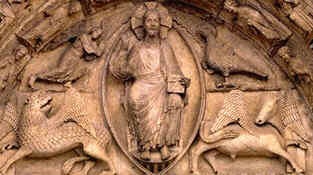 |
|
Compendia
of Knowledge (2) |
|
A
number of these works have titles suggesting a mirror or reflection of the
world; terms like Speculum, Imago
Mundi, Image du Monde. These titles, and
the attempt at universality in the content, suggest that the book in some
sense encapsulates the world. While the world is the work of the creator,
the book is the interpretation of that world by man. This concept of a book
makes it much more than a collections of words describing the world, but it
somehow is a world in its own right. The structure of the book represents
the author's concept of the structure of the world. |
|
|
|
Christ
sits in majestic judgement over the west portal of Chartres cathedral, flanked
by the symbols of the evangelists. He is holding a book, perhaps his superior
version of the book of the world. |
|
Medieval
literate culture was based in a concept of a body of authoritative texts.
The process of accumulation of knowledge of the world involved the compilation
of such sources into a structured text. The process would be called plagiarism
in modern scholarship as sources were assembled, edited, contextualised and
presented anew. This was not an improper process, as the original authors
were often cited in the prologues to give legitimacy to the work. These encyclopedic
works demonstrate perhaps best of all that medieval literate culture was a
reflexive study of the written word itself rather than original observations
of the world. The world created by the book of the world was a little world
of scholarship and learning, not the big bad nasty world of plague, wars and
famine. |
|
|
Pope
Gregory the Great may have got the authority for his writings from a dove,
as depicted here on a portal figure from Chartres Cathedral, but other authors
relied on authority from their predecessors. |
|
The
massive compilation of Isidore of Seville spread rapidly across the monasteries
of Europe at a time when these expanding institutions were working furiously
to collect libraries of texts for teaching, preaching and their own education.
The work was essentially a library in itself. One might think that such compilations
would have lesser value as libraries steadily enlarged and a greater range
of works was more widely dispersed. On the contrary, these libraries in a
box developed and grew, with more commentary and allegory added to the basic
texts. |
 |
The
rise of the preaching orders, the Dominicans and Franciscans, in the 13th
century, resulted in greater need for compiled material from which material
for sermons and preaching could be abstracted. Vincent of Beauvais, who produced
the biggest medieval encyclopedia of the lot, Speculum
Maius, was a Dominican. In the 13th century new material was added
to these works, but still under the banner of older authorities such as Aristotle,
some mostly anonymous late antique authors and some Arab authors. |
|
The
Dominicans packed them in the aisles in large churches like this one in Norwich.
The huge nave has been turned into a hall for concert performances and the
like. |
|
The
most comprehensive of the works arranged their material under four major
topics which encompassed all the phenomena of the world: the cosmos, history,
science and ethics. The ordering of these topics was different in different
works, and not all were covered in every work. In the simplest form of
the genre, only the cosmos was dealt with. Some sections of these compilations
also appeared as individual works. The text of sections on animals could
be essentially the same as those of a bestiary.
Sections on minerals were also produced in separate works referred to
as lapidaries. |
|
|
The
moral qualities of mythical beasts like the unicorn were expounded in the
encyclopedias, as in the bestiaries. This depiction is on a misericord in
Lincoln Cathedral. |
|
Some
works had names like De Natura Rerum (On
the Nature of Things), suggesting that they were all about everything.
Others like Brunetto Latini's Trésor or works with names that refer to flowers, like Liber
Floridus or Hortus Deliciarum, suggest
a selection of the best bits, as in the term florilegium.
Either way, they represent approaches to learning in which disengaged
scientific curiosity is not enough. Knowledge of the works of the creator
was a moral act with a greater purpose. |
|
The
fact that these works survived, grew and developed from the Dark Ages
through into the era of printed books suggests that their meaning to readers
changed over the centuries.
|
 previous
page previous
page |
 Categories
of Works Categories
of Works |
|
 |
 |
 |
 |



